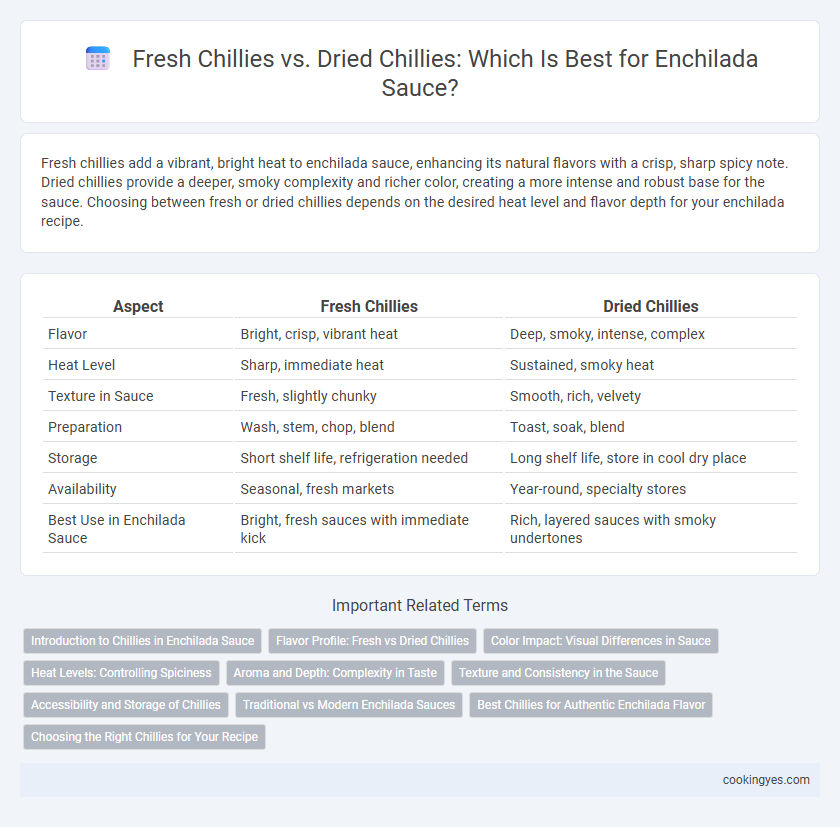Fresh chillies add a vibrant, bright heat to enchilada sauce, enhancing its natural flavors with a crisp, sharp spicy note. Dried chillies provide a deeper, smoky complexity and richer color, creating a more intense and robust base for the sauce. Choosing between fresh or dried chillies depends on the desired heat level and flavor depth for your enchilada recipe.
Table of Comparison
| Aspect | Fresh Chillies | Dried Chillies |
|---|---|---|
| Flavor | Bright, crisp, vibrant heat | Deep, smoky, intense, complex |
| Heat Level | Sharp, immediate heat | Sustained, smoky heat |
| Texture in Sauce | Fresh, slightly chunky | Smooth, rich, velvety |
| Preparation | Wash, stem, chop, blend | Toast, soak, blend |
| Storage | Short shelf life, refrigeration needed | Long shelf life, store in cool dry place |
| Availability | Seasonal, fresh markets | Year-round, specialty stores |
| Best Use in Enchilada Sauce | Bright, fresh sauces with immediate kick | Rich, layered sauces with smoky undertones |
Introduction to Chillies in Enchilada Sauce
Fresh chillies bring a vibrant, fruity heat with bright, crisp flavors that enhance enchilada sauce's freshness and complexity. Dried chillies, such as guajillo or ancho, offer deeper, smoky, and slightly sweeter notes that create a rich, robust base for traditional enchilada sauces. Combining both forms allows chefs to balance sharpness and depth, achieving a sauce with layered heat, complexity, and authentic Mexican flair.
Flavor Profile: Fresh vs Dried Chillies
Fresh chillies offer a bright, vibrant flavor with a crisp heat that enhances the freshness of enchilada sauce, providing a fruity and sharp taste. Dried chillies deliver a deeper, smoky, and more complex flavor profile, with earthy undertones that enrich the sauce with a robust, slightly sweet, and sometimes spicy warmth. Combining fresh and dried chillies can balance brightness and depth, creating a rich, multi-dimensional enchilada sauce.
Color Impact: Visual Differences in Sauce
Fresh chillies produce an enchilada sauce with vibrant red or green hues, enhancing its visual appeal and signaling freshness. Dried chillies contribute deeper, richer, and often darker shades, providing a more intense and earthy color profile ideal for traditional dishes. The choice between fresh and dried chillies directly influences the sauce's color impact, affecting presentation and perceived flavor intensity.
Heat Levels: Controlling Spiciness
Fresh chillies offer a bright, sharp heat ideal for a lively enchilada sauce, allowing precise control over spiciness by adjusting the amount of seeds and membranes used. Dried chillies, such as ancho or guajillo, provide a deeper, smoky heat with more complexity, making it easier to achieve a rich, moderate spiciness that mellows during cooking. Combining fresh and dried chillies can balance heat levels while adding layers of flavor, crucial for a well-rounded enchilada sauce.
Aroma and Depth: Complexity in Taste
Fresh chilies contribute a bright, vibrant aroma and a subtle, crisp heat to enchilada sauce, enhancing its freshness and complexity. Dried chilies offer a deeper, more concentrated flavor profile with smoky, earthy undertones that add richness and depth to the sauce. Combining both fresh and dried chilies creates a balanced enchilada sauce with layered flavors and a multi-dimensional taste experience.
Texture and Consistency in the Sauce
Fresh chillies contribute a vibrant, slightly crunchy texture and a lighter consistency to enchilada sauce, enhancing its freshness and subtle heat. Dried chillies, when rehydrated and blended, create a thicker, richer, and more velvety sauce, intensifying the deep, smoky flavor profile. The choice between fresh and dried chillies significantly affects the sauce's mouthfeel and density, with dried varieties offering a dense, smooth texture ideal for traditional enchilada sauces.
Accessibility and Storage of Chillies
Fresh chillies offer vibrant flavors and easy accessibility during peak seasons but require refrigeration and have a short shelf life, limiting long-term storage. Dried chillies, widely available year-round and more compact, provide extended shelf stability without refrigeration, ideal for maintaining consistent enchilada sauce flavor. Choosing between fresh and dried chillies impacts sauce preparation based on accessibility and storage considerations.
Traditional vs Modern Enchilada Sauces
Traditional enchilada sauces often rely on dried chillies such as ancho, guajillo, and pasilla to provide depth, smokiness, and a complex flavor profile through slow rehydration and blending. Modern enchilada recipes frequently incorporate fresh chillies like jalapenos, serranos, or chipotles to introduce brighter, sharper heat and a more vibrant, herbaceous taste. The choice between fresh and dried chillies significantly impacts the sauce's texture, color, and overall flavor intensity, with dried chillies yielding a richer, earthier sauce while fresh chillies create a more pungent and lively profile.
Best Chillies for Authentic Enchilada Flavor
Fresh chilies like poblano and jalapeno offer a vibrant, bright heat and slightly sweet flavor that enhances enchilada sauces with a lively and fresh profile. Dried chilies such as ancho, guajillo, and chipotle provide deep, smoky, and earthy tones essential for an authentic enchilada sauce, delivering complex layers of flavor. Combining fresh and dried chilies in enchilada sauce achieves the optimal balance between freshness and traditional richness, crucial for an authentic Mexican taste.
Choosing the Right Chillies for Your Recipe
Fresh chillies offer a bright, vibrant flavor and crisp texture, making them ideal for enchilada sauces that require a lively, spicy kick. Dried chillies, such as ancho or guajillo, provide deep, smoky, and complex undertones that enhance the richness and authenticity of traditional enchilada sauces. Selecting the right chillies involves balancing heat, flavor depth, and the desired sauce consistency to create the perfect enchilada experience.
Fresh chillies vs dried chillies for enchilada sauce making Infographic

 cookingyes.com
cookingyes.com